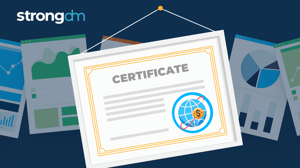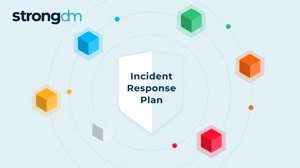
- Role-based, attribute-based, & just-in-time access to infrastructure
- Connect any person or service to any infrastructure, anywhere
- Logging like you've never seen

The NIS2 Directive establishes comprehensive cybersecurity legislation across the European Union. Building upon its predecessor, the Network and Information Security (NIS) Directive, the goal of NIS2 is to standardize cybersecurity practices among EU Member States. Much like the General Data Protection Regulation (GDPR), NIS2 seeks to unify strategies and actions throughout the EU to fortify digital infrastructure against the escalating threat of cyberattacks.
Cyberattacks and data breaches are increasingly impacting organizations and businesses throughout the EU. In response to this evolving threat landscape, the European Union Agency for Cybersecurity (ENISA) has issued a report highlighting new forms of phishing and zero-day exploits that are effectively targeting entities across the EU.
NIS2, with its broad applicability, aims to bolster cybersecurity measures across critical sectors such as energy, retail, transport, banking, health, and public administration. It also addresses the security of supply chains and service providers operating across borders.
The directive came into effect on January 16, 2023. EU Member States are required to transpose NIS2 into their national legislation by October 17, 2024, thereby ensuring its enforcement.
How EU Organizations Can Leverage NIS2 to Improve Security Measures
In the current landscape, organizations are under pressure to build capabilities to effectively manage cyber crises. In recent years, cyberattacks on critical infrastructure have surged globally. The shift to remote work during the pandemic has introduced new vulnerabilities, leading to increased susceptibility to phishing attacks. Moreover, amidst the current geopolitical climate, the risk of cyberattacks has escalated, particularly for entities providing essential services that could be targeted in hybrid warfare.
NIS2 aims to fortify organizations' security defenses against evolving cyber threats, potentially bringing about significant changes in operational approaches. Depending on your organization's maturity and market conditions, the following areas are crucial focuses for safeguarding critical infrastructure and ensuring compliance with NIS2:
- Determine if your organization falls under NIS2 scope.
- Evaluate current compliance levels with NIS2 requirements through gap assessments.
- Secure adequate cybersecurity funding.
- Conduct risk assessments pertaining to network and information systems.
- Provide comprehensive training and awareness programs for management and staff.
- Streamline incident reporting and strengthen incident management protocols.
- Assess the security of your supply chain and establish robust third-party risk management procedures.
- Develop or refine business continuity and disaster recovery plans.
How StrongDM Supports NIS2, Article 21 - Cybersecurity Risk Management Measures
NIS2 places demands on both technical infrastructures and organizational capabilities. Article 21 explains the specific “...technical, operational and organizational measures to manage the risks posed to the security of network and information systems…” lists the following measures it encompasses (the following is copied directly from the NIS2 document):
- Policies on risk analysis and information system security
- Incident handling
- Business continuity, such as backup management and disaster recovery, and crisis management
- Supply chain security, including security-related aspects concerning the relationships between each entity and its direct suppliers or service providers
- Security in network and information systems acquisition, development and maintenance, including vulnerability handling and disclosure
- Policies and procedures to assess the effectiveness of cybersecurity risk-management measures
- Basic cyber hygiene practices and cybersecurity training
- Policies and procedures regarding the use of cryptography and, where appropriate, encryption
- Human resources security, access control policies and asset management
- The use of multi-factor authentication or continuous authentication solutions, secured voice, video and text communications and secured emergency communication systems within the entity, where appropriate.
These requirements cover a broad range of security, operations, and organizational elements. Meeting these requires establishing effective behavioral controls (internal policies, staff training), but most of these can also be governed through controls and policies for access and actions.
StrongDM’s Zero Trust PAM helps EU organizations adhere to the rules and regulations that impact what, how, and when they are meeting their compliance requirements. Using fine-grained context-based privileged action controls, StrongDM can help companies achieve compliance with the NIS2 Directive by enhancing the security of their environment. Here’s how its specific capabilities contribute to this compliance:
Zero Trust PAM and Just-in-Time Workflows
NIS2 emphasizes the importance of robust access control to critical infrastructure. StrongDM's Zero Trust PAM allows organizations to control access to essential resources effectively. Just-in-Time (JIT) workflows enable access to be granted only when necessary and for the duration needed, minimizing the risk window when sensitive resources can be exposed to potential threats. This aligns with NIS2's requirements for secure and resilient systems and limits unnecessary exposure of critical systems.
Strong Policy Engine
The directive calls for measures that ensure data security and system integrity. StrongDM’s policy engine facilitates fine-grained, contextual authorization. This means that access decisions can be made in real-time based on the context of the access request, considering factors like user role, location, and time of access. This capability ensures that only the right personnel with the correct privileges can access sensitive systems, adhering to the principle of least privilege—a critical aspect of NIS2 compliance.
Continuous Authorization and Device Posture Assessment
NIS2 requires continuous monitoring and quick responsiveness to potential security incidents. StrongDM’s continuous authorization and assessment of device posture throughout a session help in ensuring that the security status of devices and users remains compliant throughout the interaction with the network. If a device falls out of compliance, for example, by violating security policies or exhibiting signs of compromise, access can be dynamically revoked to prevent unauthorized access and mitigate risks, which is a requirement under NIS2 for maintaining ongoing security and resilience.
These features of StrongDM provide a robust framework to ensure that access to critical and sensitive systems is controlled, monitored, and secured in alignment with the NIS2 Directive’s requirements. This helps EU organizations not only to comply with legal requirements but also to enhance their overall cybersecurity posture.
How StrongDM Supports NIS2, Article 23 - Reporting Obligations
Article 23 of the NIS2 Directive concerns reporting obligations. It outlines the requirements for organizations to notify relevant authorities about any significant incidents affecting the security of network and information systems that they use to provide essential or important services.
The key aspects of Article 23 include:
- Notification Requirements
- Thresholds and Parameters
- Timelines for Reporting
- Information to be Included in Notifications
The intent of Article 23 is to ensure a coordinated response to cybersecurity incidents, enhancing the overall resilience of network and information systems across the EU. StrongDM supports these reporting goals through comprehensive, fine-grained insights across all actions occurring within an environment. It provides:
Complete Visibility of Access and Actions
NIS2 emphasizes the importance of monitoring and logging access to network and information systems. StrongDM provides comprehensive visibility into access and user actions, recording details such as which users access what resources, from which IP addresses, and the specific actions they perform. This granular level of detail supports proactive security monitoring and forensic analysis, enabling organizations to detect, respond to, and mitigate issues swiftly and effectively.
Detailed Policy Monitoring Logs (PARC) Comprehensive Audit Logs
The Directive requires entities to maintain an effective and robust security governance framework, which includes detailed logging of security-related events. StrongDM's privileged session recording and activity logs provide an exhaustive audit trail that includes principal involvement, the specific activities performed, the resources accessed, contextual data of the user session, and additional security measures such as Multi-Factor Authentication (MFA) and approval workflows. These comprehensive logging and audit recordings help in understanding and auditing the authorization and access patterns, which is crucial for compliance and security assessments.
Built-in External Logging Capabilities
NIS2 mandates entities to report significant incidents to relevant national authorities within strict timelines. StrongDM’s capability to store or export logs ensures that logs are not only centralized but can also be easily exported and analyzed as needed. This facilitates compliance with reporting obligations under NIS2 by enabling quick, efficient, and accurate reporting of security incidents.
Quick Incident Identification, Assessment, and Reporting
The compressed timeline requirements for incident reporting under NIS2 require organizations to be capable of quickly identifying and assessing incidents. StrongDM's logging and visibility capabilities enable organizations to detect anomalies and potential security incidents rapidly. The detailed logs allow for a quick assessment of the scope and impact of an incident, which is essential for fulfilling the directive’s stringent reporting timelines. With StrongDM, you can create alerts for any anomalous activity using the user activity analytics dashboard. By streamlining the process of incident detection and reporting, StrongDM helps organizations meet the directive’s demands for timely and effective communication with national authorities.
StrongDM gives EU organizations the tools required to effectively manage access, monitor and log all activities (across all resources) in detail, and report incidents promptly, all of which are essential for complying with the NIS2 Directive. This ensures that organizations can not only comply with legal requirements but also enhance their overall security posture to protect critical infrastructure and sensitive data.
To see StrongDM in action, book a demo.
About the Author
Fazila Malik, Sales Enablement Expert, as an accomplished Product Marketing Manager in the technology industry with over 5 years of experience, Fazila transitioned to a Sales Enablement leader position passionate about empowering go-to-market teams to excel in their roles. Throughout her career, she has worked with a range of technology products, including software applications and cloud-based solutions. Fazila is a member of the Product Marketing Alliance and an AWS Cloud Certified Practitioner. To contact Fazila, visit her on LinkedIn.

You May Also Like




